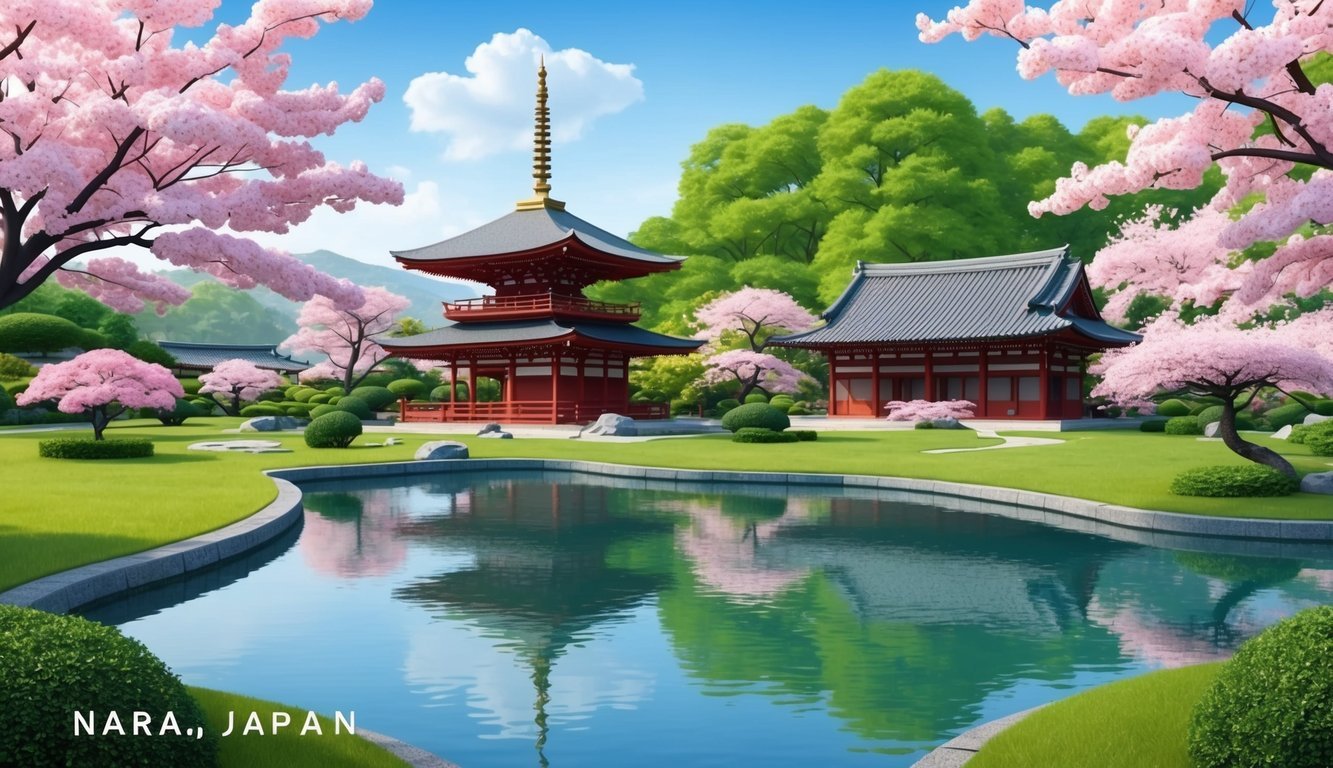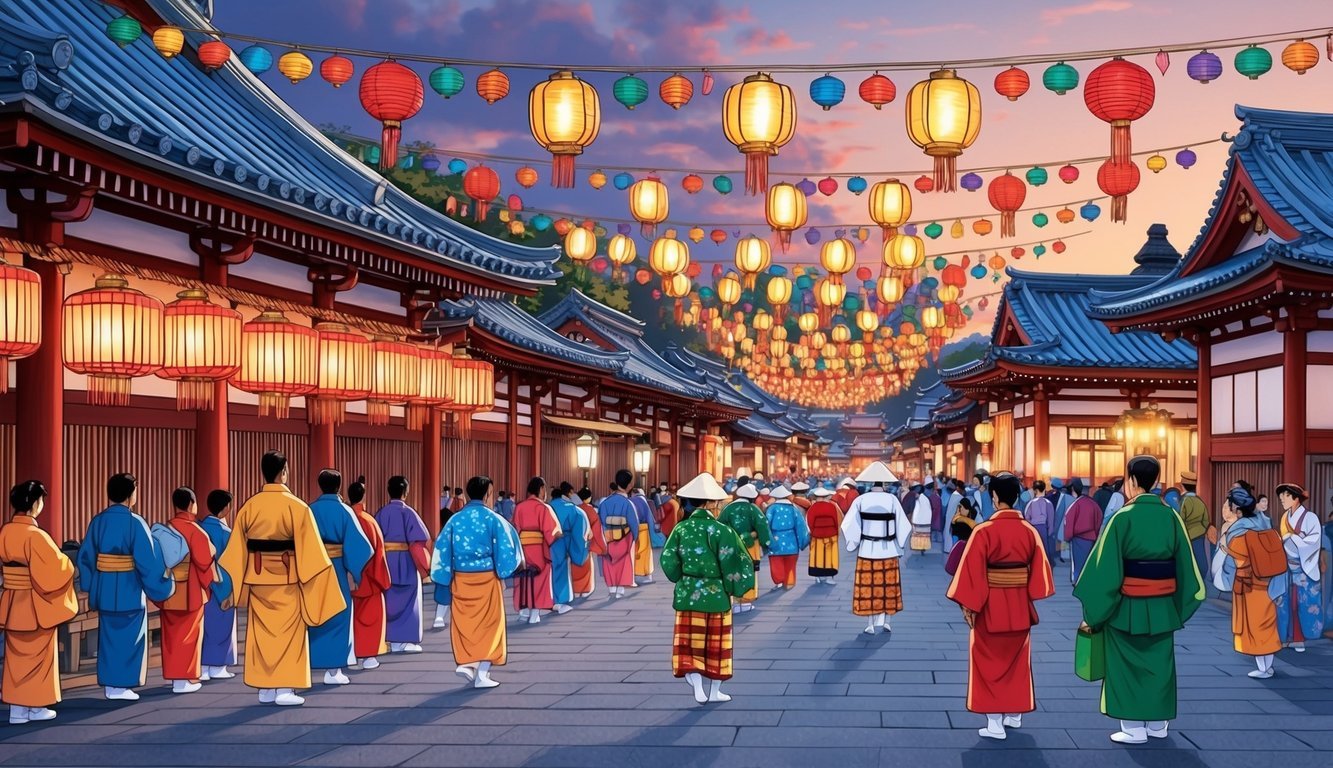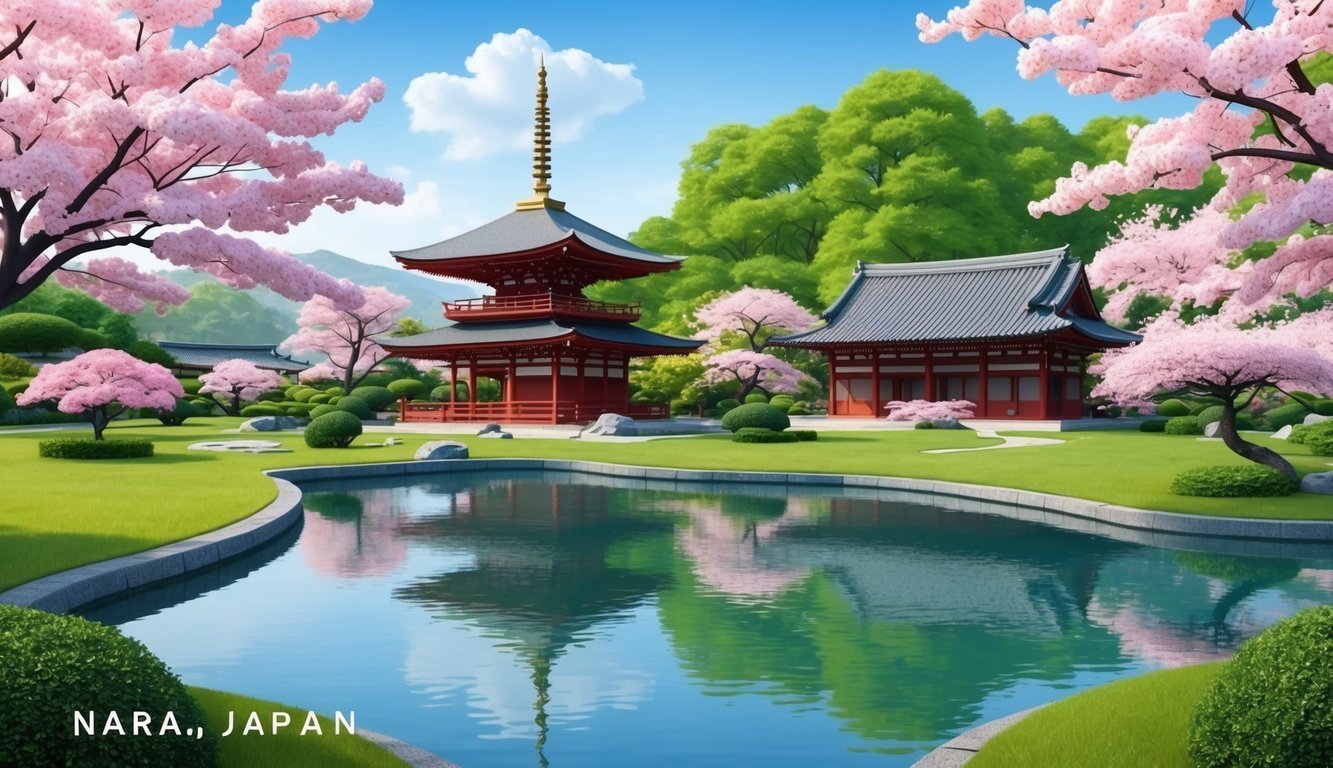Nara, Japan, is a city teeming with history and culture that offers a unique glimpse into Japan’s past.
In 710, Nara became Japan’s first permanent capital.
It is home to some of the country’s most important cultural heritage sites.
Whether you’re wandering through the majestic Todai-ji Temple or enjoying the friendly deer in Nara Park, you’ll find plenty of reasons to fall in love with this ancient city.

As you explore Nara, you’ll encounter a rich tapestry of stories and experiences that go beyond its iconic landmarks.
The blend of nature and history makes for an unforgettable adventure.
From scenic trails in the surrounding mountains to traditional festivals that celebrate local customs, you’ll discover a place that truly captures the essence of Japan.
Visiting Nara not only enriches your understanding of Japanese culture but also provides countless opportunities for delightful dining and memorable experiences.
You’ll enjoy savoring local flavors and engaging with the vibrant culture that Nara has to offer.
Key Takeaways
- Nara is the first permanent capital of Japan, rich in history and culture.
- The city features stunning landmarks and beautiful natural spots for exploration.
- Delicious local cuisine and vibrant festivals enhance the visit to Nara.
History and Cultural Significance
Nara, as Japan’s first permanent capital, played a crucial role in shaping the country’s history and culture.
Its significance stems from its rich heritage, marked by the establishment of important temples and the influence of Buddhism and Shinto beliefs.
The Birth of Japan’s First Permanent Capital
In 710 CE, Nara became known as Heijokyo and served as Japan’s first permanent capital.
This marked a major shift from the earlier Asuka period, where capitals often changed location.
Heijokyo was modeled after the layout of the Chinese city of Chang’an, featuring a grid pattern and a central palace.
During this time, Emperor Shomu initiated significant construction projects, including the famed Todaiji Temple and the Great Buddha statue.
This temple is now a UNESCO World Heritage Site and showcases the architectural skills of that era.
The capital functioned until 784 CE when it moved to Kyoto, but its influence remained strong.
Influence of Buddhism and Shinto Shrines
Buddhism, introduced in the 6th century, became a vital part of Nara’s culture.
Temples like Todai-ji not only served as places of worship but also as centers for learning and culture.
They housed scholars and monks who contributed greatly to Japanese literature and art.
Shinto shrines also flourished during this time, reflecting Japan’s indigenous beliefs.
The blend of these two religions in Nara created a unique cultural landscape.
Visitors can see this rich spiritual heritage when exploring Nara, with sites like Kasuga-taisha Shrine highlighting the beauty of Shinto architecture.
Historical Ties with Kyoto and Osaka
Nara’s historical ties with Kyoto and Osaka are noteworthy.
After Nara ceased to be the capital, the newly established Kyoto drew inspiration from its predecessor.
The layout and design of Kyoto maintained elements from Heijokyo.
Osaka, located nearby, grew as a significant commercial center, further intertwining its fate with Nara.
Together, these cities tell the story of Japan’s evolution from ancient times to modernity.
As you stroll through Nara, you encounter the echoes of this rich shared history, making it a must-visit site for history enthusiasts.
Nara’s Iconic Landmarks
Nara is home to some of Japan’s most treasured landmarks.
These sites highlight its rich history and stunning architecture.
Here, you’ll discover key temples and shrines that attract many visitors.
Todai-ji Temple and the Great Buddha
Todai-ji Temple is one of Nara’s most famous attractions.
Built in the 8th century, it houses the Great Buddha, also known as Daibutsu.
This impressive bronze statue stands at 14.98 meters tall.
You can find it inside the Great Buddha Hall, which is the world’s largest wooden building.
As you explore, take a moment to appreciate the temple’s beautiful architecture.
The intricate details and massive wooden beams are truly remarkable.
The temple is part of the UNESCO World Heritage sites, showcasing its historical significance.
Don’t forget to stroll through the surrounding Nara Park, where friendly deer roam freely.
Kasuga Taisha Shrine and the Primeval Forest
Next, visit Kasuga Taisha Shrine, famous for its beautiful lanterns.
Established in 768, it serves as the shrine for the powerful Fujiwara clan.
As you walk through the approach to the shrine, you’ll see hundreds of stone and bronze lanterns.
The shrine is nestled in the Kasugayama Primeval Forest, a UNESCO World Heritage site.
This forest is home to diverse flora and fauna, offering a peaceful natural setting.
Explore the many trails around the shrine that lead you deeper into the woods.
The serene atmosphere here makes it a perfect spot for reflection.
Nara National Museum and Naramachi District
Don’t miss the Nara National Museum, which showcases ancient Japanese art and history.
It’s located near Nara Park, making it easy to fit into your sightseeing.
The museum hosts a variety of exhibitions, including Buddhist art, ceramics, and historical artifacts.
After visiting the museum, take a stroll through the Naramachi District.
This area features traditional wooden buildings from the Edo period.
As you explore the quaint shops and cafes, you’ll get a feel for what life in Nara was like centuries ago.
Both the museum and district provide a rich glimpse into Nara’s cultural heritage.
Exploring Nara’s Natural Beauty
Nara is a paradise for nature lovers, offering stunning parks, serene gardens, and breathtaking views.
You can enjoy the gentle presence of deer while exploring lush greenery and marvel at beautiful cherry blossoms in season.
Here’s what you can experience.
The Charm of Nara Park and Its Deer
Nara Park is a must-visit for anyone in the area.
This vast park is home to around 1,200 friendly Sika deer that roam freely.
As you wander the pathways, you’ll encounter these gentle creatures, which are considered a symbol of Nara.
The park has many attractions, including impressive temples and lush landscapes.
You can grab deer crackers from nearby vendors to feed them, making for a delightful experience.
Don’t miss the stunning scenery that changes with the seasons, providing unique photographic opportunities.
Strolls Through Japanese Gardens
Nara is famous for its beautiful Japanese gardens, particularly Isuien Garden and Yoshikien Garden.
At Isuien, you’ll find a tranquil space that showcases traditional Japanese landscaping.
The garden features ponds, tea houses, and cherry trees, allowing for peaceful moments.
Similarly, Yoshikien Garden offers three distinct styles: a pond garden, a moss garden, and a tea garden.
Each section presents seasonal beauty, with stunning flowers blooming at different times of the year.
A stroll through these gardens is like stepping into a painting, perfect for relaxation and enjoyment.
Cherry Blossoms at Yoshino
If you visit during spring, a trip to Yoshino is essential.
This area is famous for its cherry blossoms, with thousands of trees lining the hillsides.
The beautiful pink flowers create a stunning landscape that attracts visitors from all over.
Mount Yoshino is often bustling with people who come to admire the sight.
The best spots for viewing include the path to the summit and various lookout points.
Experience the beauty of cherry blossoms in full bloom—a truly unforgettable sight that celebrates nature at its finest.
Cultural Experiences and Festivals

Nara offers a unique blend of cultural experiences and vibrant festivals that truly reflect its rich heritage.
You’ll find traditional crafts, exciting local events, and a chance to connect with Zen practices in this beautiful city.
Mochi Pounding and Traditional Craftsmanship
Mochi pounding is a fun and hands-on activity you can experience in Nara.
This age-old tradition involves soaking glutinous rice, steaming it, and then pounding it into a sticky dough.
You can join workshops where locals show you the process.
In addition to mochi, Nara is known for its traditional crafts.
You can find exquisite items like Nara busts and hand-painted ceramics.
Visiting local workshops, you might even get a chance to try your hand at these crafts.
Many places, such as the Neiraku Museum, showcase these cultural artifacts.
Zen Practices and Spiritual Retreats
Nara’s tranquil environment is perfect for exploring Zen practices.
Temples scattered throughout the city offer meditation sessions and spiritual retreats.
You can take part in zazen (seated meditation) to help clear your mind and connect with the serene atmosphere.
For those seeking deeper spirituality, many retreats provide a peaceful escape from daily life.
These experiences often include tea ceremonies and guided sessions by knowledgeable monks.
You’ll leave feeling rejuvenated and connected to Japanese culture.
Annual Events and Matsuris
Nara hosts several exciting festivals throughout the year, showcasing its rich traditions.
One of the most famous is Omizutori, a stunning fire festival held at Todai-ji Temple in March.
Here, you’ll see monks carry flaming torches and perform rituals that celebrate the arrival of spring.
Another highlight is the Wakakusa Yamayaki festival in January.
During this event, the grassy hills around Nara Park are set ablaze in a spectacular display.
As the fires burn, the lighting creates a magical atmosphere that you won’t want to miss.
Don’t forget about Obon, a festival celebrating the spirits of ancestors.
This involves traditional dances, lantern lighting, and family gatherings.
It’s a wonderful way to see local traditions in action.
Food and Dining in Nara
Nara offers a delicious mix of local flavors that reflect its rich history and culinary traditions.
You can find everything from unique local snacks to traditional meals, along with some delightful treats.
Here’s what you shouldn’t miss when dining in Nara.
Sampling Nara’s Local Cuisine
When you’re in Nara, don’t forget to try narazuke pickles.
These special pickles are made using seasonal vegetables and a unique sake lees marinade, giving them a distinctive taste.
Also, be sure to sample persimmon leaf sushi, where sushi is wrapped in persimmon leaves for a fragrant touch.
You can also enjoy mochi, a soft rice cake served both sweet and savory.
At local shops, you’ll find senbei, or rice crackers.
They are usually grilled or fried, offering a crunchy, delicious snack.
Traditional dining experiences can be found in places like Wa Yamamura, known for its top-tier dishes recognized by the Michelin Guide.
The Art of Sake Brewing
Nara is famous for its sake.
The craft of brewing sake dates back centuries here.
Local breweries welcome visitors for tours, where you can learn about the brewing process.
You’ll see how water, rice, yeast, and mold come together to create this beloved drink.
Don’t miss tasting different varieties.
Some breweries offer tastings and food pairings to enhance your experience. Local sake often has a smoother finish and unique flavors that are a must-try during your visit.
Street Eats and Sweet Treats
As you explore Nara, be sure to try some street eats.
You might come across stalls selling yakitori (grilled chicken skewers) or takoyaki (octopus balls).
These casual bites are perfect for a quick meal while sightseeing.
For dessert, indulge in traditional Japanese sweets such as daifuku, which is mochi filled with sweet red bean paste.
Look for shops that make these treats fresh.
Don’t forget to grab some sweet matcha treats, as they are popular and pair well with a warm cup of green tea.
Enjoying these flavors gives you a real taste of Nara’s culinary delights.
Travel Tips and Itineraries
When planning your trip to Nara, consider how to make the most of your visit.
This section will help you with essential travel tips, recommendations for a day trip, and options for where to stay and how to get around.
Planning Your Visit to Nara
Start your Nara adventure from either Kintetsu Nara Station or JR Nara Station.
Both stations offer easy access to the city’s top landmarks.
The best time to visit is during spring for cherry blossoms or autumn for vibrant foliage.
During your visit, you should wear comfortable shoes, as you’ll be walking a lot.
Don’t forget to check local events or festivals happening during your stay for a richer experience.
Day Trip Recommendations
For an efficient Nara Day Trip Itinerary, prioritize must-see spots.
Start at Nara Park to feed the famous deer.
From there, head to Todai-ji Temple, home to a massive Buddha statue.
Next, stroll around the beautiful Isuien Garden for a taste of tranquility.
As you walk, keep an eye out for hidden gems like small shrines and local shops.
Wrap up your day with a visit to Kasuga-taisha, especially stunning during sunset.
Plan to spend about 6-8 hours exploring these highlights.
Consider a local guide if you want deeper insights into the history and culture.
Accommodation and Transportation
For a comfortable stay, consider options like Yuzan Guesthouse for a cozy vibe or hotels near Nara Station for convenience.
Both provide a good base for exploring the city.
Getting around is simple.
Nara’s public transport can take you to main attractions.
If you prefer walking, many sites are close together.
From Kansai International Airport, take a train to Kintetsu Nara Station for easy access.
Have a mapped itinerary, but stay flexible to enjoy spontaneous adventures along the way.
Frequently Asked Questions

When visiting Nara, you might have a lot of questions.
This section covers the top attractions, unique experiences, getting around, and why Nara holds historical significance.
What are the top attractions to visit in Nara?
Some must-see attractions include Todai-ji Temple, famous for its giant Buddha statue, and Kasuga-taisha Shrine, known for its many lanterns.
Nara Park is also a highlight, where you can enjoy the serene atmosphere and lovely deer.
Can you interact with deer in Nara Park, and if so, how?
Yes, you can interact with the friendly deer in Nara Park.
You can feed them special deer crackers sold around the park.
Just be gentle; they can get a bit excited when food is around!
What unique experiences should you not miss when visiting Nara?
Don’t miss dressing in a traditional kimono while exploring the city.
Additionally, visiting the Yoshiki-en Garden is a lovely experience with beautiful scenery.
You can enjoy the peaceful setting and take some great photos.
How do you get to Nara from Kyoto or Osaka?
To get to Nara from Kyoto, take the Kintetsu Nara Line, which takes about 40 minutes.
From Osaka, the same line gets you there in around 45 minutes.
It’s convenient and a great way to see the countryside.
Why is Nara considered a historically significant city in Japan?
Nara was Japan’s first capital in the 8th century and is home to many historical sites.
The city played a crucial role in the development of Japanese art, culture, and Buddhism, making it a key point in Japan’s history.
What are some recommended tours or activities to do in Nara?
Consider joining a guided walking tour to learn about Nara’s rich history.
You might also enjoy a food tour to taste local delicacies.
Bike rentals are a fun option, allowing you to explore the city at your own pace.

